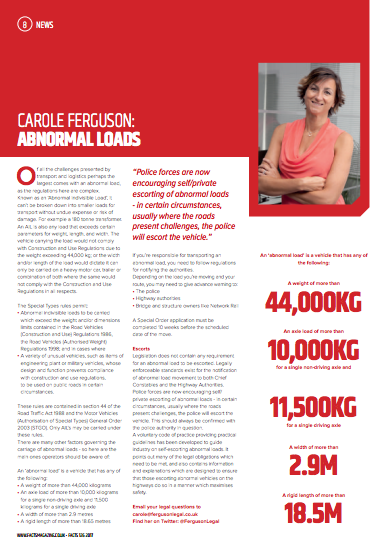Of all the challenges presented by transport and logistics perhaps the largest comes with an abnormal load, as the regulations here are complex.
Known as an ‘Abnormal Indivisible Load’, it can’t be broken down into smaller loads for transport without undue expense or risk of damage. For example, a 180 tonne transformer.
An AIL is also any load that exceeds certain parameters for weight, length, and width. The vehicle carrying the load would not comply with Construction and Use Regulations due to the weight exceeding 44,000 kg; or the width and/or length of the load would dictate it can only be carried on a heavy motor car, trailer or combination of both where the same would not comply with the Construction and Use Regulations in all respects.
The Special Types rules permit:
- abnormal indivisible loads to be carried which exceed the weight and/or dimensions limits contained in the Road Vehicles (Construction and Use) Regulations 1986, the Road Vehicles (Authorised Weight) Regulations 1998; and in cases where
- a variety of unusual vehicles, such as items of engineering plant or military vehicles, whose design and function prevents compliance with construction and use regulations, to be used on public roads in certain circumstances.
These rules are contained in section 44 of the Road Traffic Act 1988 and the Motor Vehicles (Authorisation of Special Types) General Order 2003 (STGO). Only AIL’s may be carried under these rules.
There are many other factors governing the carriage of abnormal loads – so here are the main ones operators should be aware of:
An ‘abnormal load’ is a vehicle that has any of the following:
- a weight of more than 44,000 kilograms
- an axle load of more than 10,000 kilograms for a single non-driving axle and 11,500 kilograms for a single driving axle
- a width of more than 2.9 metres
- a rigid length of more than 18.65 metres
If you’re responsible for transporting an abnormal load, you need to follow regulations for notifying the authorities.
Depending on the load you’re moving and your route, you may need to give advance warning to:
- the police
- highway authorities
- bridge and structure owners like Network Rail
A Special Order application must be completed 10 weeks before the scheduled date of the move.
Escorts
Legislation does not contain any requirement for an abnormal load to be escorted. Legally enforceable standards exist for the notification of abnormal load movement to both Chief Constables and the Highway Authorities.
Police forces are now encouraging self/private escorting of abnormal loads – in certain circumstances, usually where the roads present challenges, the police will escort the vehicle. This should always be confirmed with the police authority in question.
A voluntary code of practice providing practical guidelines has been developed to guide industry on self-escorting abnormal loads. It points out many of the legal obligations which need to be met, and also contains information and explanations which are designed to ensure that those escorting abnormal vehicles on the highways do so in a manner which maximises safety.
This article was first published in FACTS magazine: www.factsmagazine.co.uk




